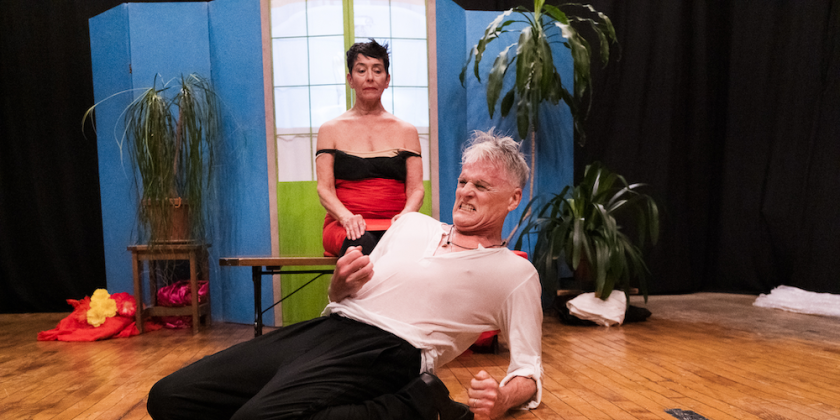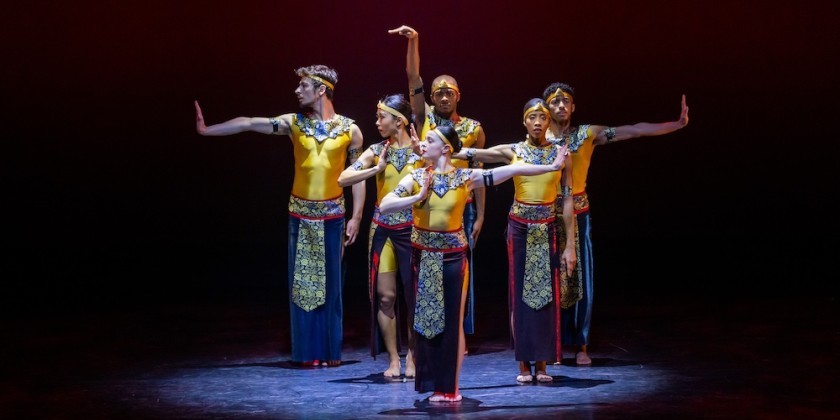IMPRESSIONS: Mark DeGarmo's "Las Fridas: An Offering for the Days of the Dead" at The Clemente Center

Choreographer & Director: Mark DeGarmo
Performers: Marie Baker-Lee & Mark De Garmo
Venue: MDD Studio Theater 310, The Clemente Center
After wandering my way through the galleries of the Clemente Center, I enter the Mark DeGarmo Dance Studio Theater and am at first underwhelmed. Upon initially scanning the space, it feels minimal. But when further settling into my metal folding chair, I observe drapery meticulously accordion-folded on either side of the stage; plants framing both sides of a large blue partition; and faux flowers, with garments for future costume changes hiding themselves on the floor. All this is centered on the large partition upstage painted that shade of blue that Frida Kahlo fans immediately recognize as the Blue House in Mexico City where Kahlo spent much of her life.
In the center of the house, a faux window hosts a silent moving projection of hands gliding, rather than wringing, against each other. A simple wooden bench downstage of the Blue House later supports dancers Mark DeGarmo and Marie Baker-Lee as they sit, lay, lean, and more. In this intimate space, evenly-lit, with no difference between “house” lights and “stage” lights, we have no choice but to be present with the performers.

LAS FRIDAS... divides the 60-minute evening into two parts with subheadings. Part One is called, “Innocence: The Blue House” and Part Two is called “Experience:Ribbon around a Bomb,” each with 8 bullet pointed sections. As DeGarmo and Baker-Lee enter in silence, their presence instantly dictates how we should take them in— fully, with abandon and reverence. As a millennial, I instantly note how refreshing and beautiful it is to see bodies with more years than mine moving in space and commanding attention.
DeGarmo created LAS FRIDAS... over the course of more than a decade, with one of his leading questions being, “What would Frida’s life be like if she lived past 47?” I wasn’t aware, until after I saw the work, that choosing two dancers over the age of 60 was not intentional. DeGarmo put himself in the piece only after his original dancer was no longer able to complete the project. As I watched, even without that prior knowledge, the choice felt essential. We don’t experience enough older dancers making and dancing in work that holds relevance to both the present dance landscape and the current state of humanity.
I also can’t stop thinking about the decision to host this piece in such an intimate space. LAS FRIDAS, Offering for Days of the Dead, which honors the women in DeGarmo’s life who’ve inspired and mentored him, would not have held the same sacred tone in a venue any larger. Every moment held ritualistic intent, from Part Two’s closing with the same movement phrase that opened Part One, to the the deliberate manner in which the two artists changed costumes on set — always unrushed, and carefully folding each garment before placing it on the ground.

Journeying through the many phases of Frida’s life with the two performers billed as Dark Frida and Light Frida, I realize within the first five minutes that each Frida is in relationship, not with the other, but within themselves. What I don’t realize is that I’ve confused who’s who within those roles. Baker-Lee is billed as Dark Frida and DeGarmo as Light Frida. I assumed it was the other way around. And why wouldn’t I? DeGarmo first appears dressed in a black suit with makeup on his face, dramatizing his eyebrows and the lines around his eyes, while Baker-Lee wears a vibrant huipil of hot pink, multicolored flowers, and bright blues. Soon the concepts of “light” and “dark” become further blurred. By the time we get to Part 2, both Fridas seem to be fighting internal battles. Baker-Lee sheds her huipil and now is also all in black.
In the subsection of Part 2 called “Love,” Baker-Lee performs a stand-out solo. Entering in an oversized suit jacket with an ever-so-slight smirk on her face her presence, intention, and storytelling bring out a spirit that feels unmatched for the rest of the evening (with the exception of her final moment later on). Throughout Baker-Lee’s seated solo dance, she is unapologetic in her eye contact with the audience. She pulls pieces of red satin fabric out from various places on her costume: her pants pockets, the outside pockets of her suit, the inside pockets, her sleeves. In movement conversation, she presents and reveals each piece of red material. After each swathe unfurls in her hand, she slams it to the ground, repeating this action with mounting speed until there is no more material left. Are the satin scarves her blood, her pain, her love, her pleasure, or all of these?

The color red is a constant. In multiple sections of “Part 2: Experience: Ribbon around a Bomb,” we witness a giant piece of red fabric being twisted, wrapped, and used to entangle, cover, or whip the air. This giant ribbon, in all instances, suggests elements of Kahlo's life with which she was desperately grappling. Eventually in the final section “Fire,” DeGarmo, with all his towering height, holds the red cloth high in front of him before laying it to the ground and finally draping it over the, (now-vertical) bench where Baker-Lee’s Frida is laid, or rather stood, to rest. As DeGarmo’s Frida performs all the formalities of funerary rites, sounds of pain and physical struggle are vocalized both in an audio track and from Baker-Lee herself. Suddenly, she jolts up, eyes-wide, eyebrows high and emits a guttural one tone scream lasting until… Blackout.

At this dire moment, when art-making seems pointless as bombs fall from the sky across the globe, this evening, presented as an offering to those who’ve passed from our realm, provided a crucial and meaningful remembrance. Leaving the studio-theater, orange marigold petals lead us over its threshold, just as they do in traditional Day of the Dead celebrations. As I walk away from the marigolds into the outside world, I feel the shift in energy. The spirits have been left behind to rest.













